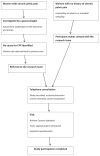Pelvic vein incompetence and chronic pelvic pain: a case-control study
- PMID: 37095613
- PMCID: PMC7616904
- DOI: 10.1111/1471-0528.17485
Pelvic vein incompetence and chronic pelvic pain: a case-control study
Abstract
Objective: To investigate the association between chronic pelvic pain (CPP) and pelvic vein incompetence (PVI) or pelvic varices.
Design: Case-control study.
Setting: Gynaecology and vascular surgery services in two teaching hospitals in north-west England.
Sample: A total of 328 premenopausal women (aged 18-54 years), comprising 164 women with CPP and 164 matched controls with no history of CPP.
Methods: Symptom and quality-of-life questionnaires and transvaginal duplex ultrasound for PVI and pelvic varices.
Main outcome measures: Venous reflux of >0.7 s in the ovarian or internal iliac veins (primary outcome) and presence of pelvic varices (secondary outcome). Statistical analysis compared the prevalence of PVI between women with and without CPP using the two-sided chi-square test. Logistic regression was used to compare the odds of having PVI and pelvic varices between women with and without CPP.
Results: Pelvic vein incompetence was found on transvaginal duplex ultrasound in 101/162 (62%) women with CPP, compared with 30/164 (19%) asymptomatic controls (OR 6.79, 95% CI 4.11-11.47, p < 0.001). Forty-three of 164 (27%) women with CPP had pelvic varices compared with three of 164 (2%) asymptomatic women (OR 18.9, 95% CI 5.73-62.7, p < 0.001).
Conclusions: There was a significant association between PVI, as detected by transvaginal duplex imaging, and CPP. Pelvic varices were strongly associated with CPP and were infrequently seen in control patients. These results justify further evaluation of PVI and its treatment in well-designed research.
Keywords: case-control study; chronic pelvic pain; pelvic venous incompetence; ultrasound; venous.
© 2023 The Authors. BJOG: An International Journal of Obstetrics and Gynaecology published by John Wiley & Sons Ltd.
Conflict of interest statement
None declared. Completed disclosure of interests form available to view online as supporting information.
References
-
- Daniels JP, Khan KS. Chronic pelvic pain in women. BMJ. 2010;341:c4834. - PubMed
-
- McGowan L, Luker K, Creed F, Chew-Graham CA. How do you explain a pain that can't be seen?: the narratives of women with chronic pelvic pain and their disengagement with the diagnostic cycle. Br J Health Psychol. 2007;12(Pt 2):261–74. - PubMed
-
- Lamvu G, Carrillo J, Ouyang C, Rapkin A. Chronic pelvic pain in women: a review. JAMA. 2021;325(23):2381–91. - PubMed
-
- Cockrum R, Tu F. Hysterectomy for chronic pelvic pain. Obstet Gynecol Clin North Am. 2022;49:257–71. - PubMed
-
- Tu FF, Hahn D, Steege JF. Pelvic congestion syndrome-associated pelvic pain: a systematic review of diagnosis and management. Obstet Gynecol Surv. 2010;65(5):332–40. - PubMed
MeSH terms
Grants and funding
LinkOut - more resources
Full Text Sources
Medical


